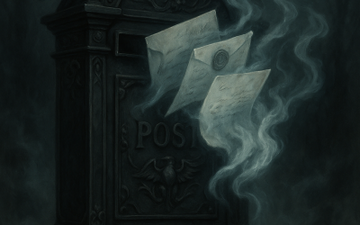
Maria and Derek Broaddus found their forever home. It sat nestled in the picturesque town of Westfield, New Jersey, and in June 2014, 657 Boulevard became their dream home. That is, until they moved in, and their dream quickly became a mysterious and terrifying nightmare.
This is the true story of The Watcher house—a tale that combines true crime, psychological horror, and real-life stalker letters that would inspire both panic and pop culture fascination. Even Netflix was intrigued to create a limited series based on the events surrounding the curious claims and psychological torment that plagued the Broaddus family in their new Westfield home.
But was this truly an unsolvable case that ultimately ran the family out of their home?
Or was it an elaborate hoax that offered them a way out of an impulsive decision?
Check the Mail
Just days after purchasing the six-bedroom Dutch Colonial, and before their renovations began, Derek Broaddus checked the mailbox and found a strange letter addressed to “The New Owner.” The envelope was handwritten, but the letter was typed and signed: “The Watcher.”
The letter’s tone was unsettling. “The Watcher” claimed that their family had watched 657 Boulevard for decades, a duty passed down through generations. And now, it was “The Watcher’s” turn:
“657 Boulevard has been the subject of my family for decades now… I have been put in charge of watching and waiting for its second coming.”
A barrage of increasingly disturbing messages followed. The Watcher referenced the Broaddus children, using their nicknames, eventually referring to them as “young blood.” Another letter came, inquiring if the family had found “what’s in the walls yet.”
Their dream home quickly transformed into a house of torment—not by ghosts, but by the sinister letters arriving in the mail with the very real threat of a stranger watching.
More Letters
The Broadduses received multiple letters over several months, each more chilling than the last:
“I am pleased to know your names now and the name of the young blood you have brought to me.”
“It has been years and years since the young blood ruled the hallways of the house. Have you found all of the secrets it holds yet?”
The author of the letters had intimate knowledge of the family. Their movement, their children’s names, the family’s routine, all private information that only someone close to the family would know, or someone consumed with watching them. The fearful parents stopped bringing their kids to the house, paused renovations, and reached out to the police.

Who’s Sus?
Local police interviewed neighbors and ran background checks, but their investigative efforts yielded no results. No suspect was ever identified. The Watcher case quickly became one of the most notorious unsolved mysteries in New Jersey.
But, of course, folks had their theories. A neighbor? A jealous or angry prospective buyer? The previous owners? All interesting theories, though none panned out. The Broadduses were determined. They hired private investigators, FBI profilers, and forensic linguists—even launching their own deep dive into the community’s dark corners. Still, the Watcher remained a mystery. And the charming Westfield became Manhattan’s notoriously creepy commuter town.
Lawsuits and Infamy
Unable to live in the house or sell it, the Broaddus family sued the previous owners, the Woods family, in 2015, on the grounds that they had failed to disclose a previous Watcher letter. The lawsuit didn’t hold up and was ultimately dismissed, but the media’s interest was piqued.
657 Boulevard had become infamous. It was dubbed “America’s creepiest house” in blogs, articles, and forums across the internet.
The Broadduses exhausted all their options. They attempted to tear down the house and split the lot into two, but Westfield officials rejected the proposal. They tried putting it on the market, but didn’t get any interested buyers. They were left with a house they couldn’t sell, live in, or escape from.
The Watcher Writes Again
In 2017, a family rented the house from the Broadduses. They were told about the letters, but took their chances. And in the beginning, all seemed fine. Until another letter arrived:
“You wonder who The Watcher is… Maybe you even spoke to me, one of the so-called neighbors who has no idea who The Watcher could be.”
The Watcher was still watching.
The Watcher House Back on the Market
In 2019, 657 Boulevard finally sold. The Broadusses had never lived inside the home and took a loss on the sale. The buyer, reportedly undeterred by the letters, has lived there without any publicly reported incidents, though the rumor mill was still churning out theories.
To this day, The Watcher has lain dormant, and no suspect has ever been caught. Will the mysterious letter writer eventually become an urban legend? Or is The Watcher waiting for the right time and the right family to move in before another letter is written?
The Watcher in Pop Culture
The Watcher’s eerie letters and references to the children as “young blood” inspired a wave of true crime podcasts, YouTube deep-dives, and Reddit threads. In 2022, Netflix dramatized the story in a limited series titled “The Watcher,” created by Ryan Murphy (American Horror Story), and starring Naomi Watts. In typical Ryan Murphy fashion, the series took creative liberties; however, it also reignited public interest in the chilling story of the Watcher house.
Was It a Hoax?
The theory that the Broadduses may have written the letters themselves as part of a real estate scam is still a common speculation. However, law enforcement found no evidence to support this theory. The family has always denied it, and considering the emotional toll and financial loss they endured, it’s a hard argument to make.
A Lasting Mystery
The saga of The Watcher house in Westfield is more than just a creepy, unsolvable chain letter—it’s a modern urban legend.
It taps into our fears: the loss of safety in our own homes, the dread of being watched by a stranger, and the powerlessness that comes with an unsolved mystery.
Was it simply a cruel prank, an unhinged neighbor, or something more conspiratorial? The truth remains elusive. However, one thing that we are reminded of is that, despite living in a digital age, there is still power in pen and paper.


